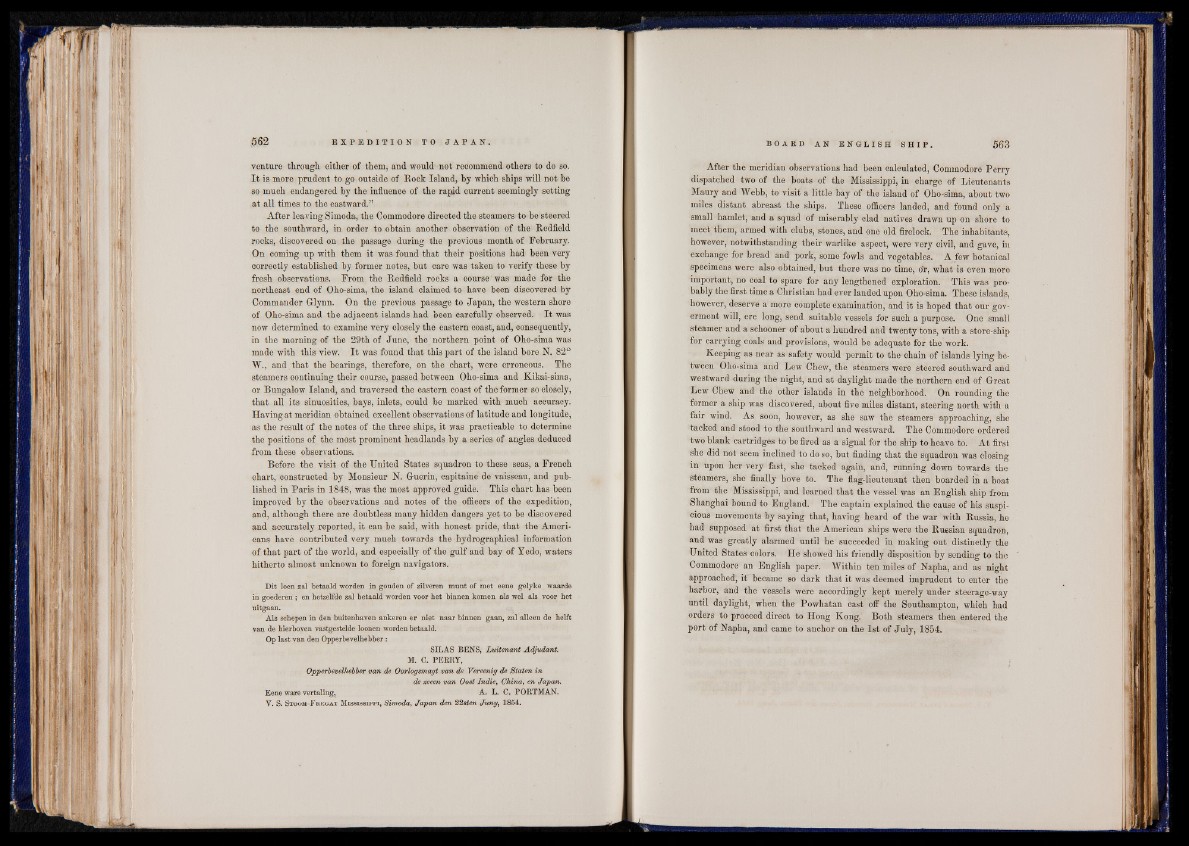
venture through either of them, and would not recommend others to do so.
I t is more prudent to go outside of Rock Island, by which ships will not be
so much endangered by the influence of the rapid current seemingly setting
at all times to the eastward.”
After leaving Simoda, the Commodore directed the steamers to be steered
to the southward, in order to obtain another observation of the Redfield
rocks, discovered on the passage during the previous month of February.
On coming up with them it was found that their positions had been very
correctly established by former notes, but care was taken to verify these by
fresh observations. From the Redfield rocks a course'was made for the
northeast end of Oho-sima, the island claimed to have been discovered by
Commander Glynn. On the previous passage to Japan, the western shore
of Oho-sima and the adjacent islands had been carefully observed. I t was
now determined to examine very closely the eastern coast, and, consequently,
in the morning of the 29th of June, the northern point of Oho-sima was
made with this view. I t was found that this part of the island bore N. 82°
W., and that the bearings, therefore, on the chart, were erroneous. The
steamers continuing their course, passed between Oho-sima and Kikai-sima,
or Bungalow Island, and traversed the eastern coast of the former so closely,
that all its sinuosities, bays, inlets, could be marked with much accuracy.
Having at meridian obtained excellent observations of latitude and longitude,
as the result of the notes of the three ships, it was practicable to determine
the positions of the most prominent headlands by a series of angles deduced
from these observations.
Before the visit of the United States squadron to these seas, a French
chart, constructed by Monsieur N. Guerin, capitaine de vaisseau, and published
in Paris in 1848, was the most approved guide. This chart has been
improved by the observations. and notes of the officers of the expedition,
and, although there are doubtless many hidden dangers yet to be discovered
and accurately reported, it can be said, with honest pride, that the Americans
have contributed very much towards the hydrographical information
of that part of the world, and especially of the gulf and bay of Yedo, waters
hitherto almost unknown to foreign navigators.
Dit loen zal betaald worden in gouden of zilveren munt of met eene gelyke waarde
in goederen ; en hetzelfde zal betaald worden voor het binnen komen als wel als voor het
nitgaan.
Als scbepen in den buitenhaven ankeren er niet naar binnen gaan, zal alleen de helft
van de hierboven vastgestelde loonen worden betaald.
Op last van den Opperbevelhebber:
SILAS BENS, Luitenant Adjudant.
M. C. PERRY,
Opperbevelhebber van de Oorlogsmagt van de Vereenig de Staten in
de zeeen van Oost Indie, China, en Japan.
Eene ware vertaling, A. L. C. PORTMAN.
Y. S . S t o o m - F r k g a t M i s s i s s i p p i , Simoda, Japan den 22sten Jv/rvy, 1854.
After the meridian observations had been calculated, Commodore Perry
dispatched two of the boats of the Mississippi, in charge of Lieutenants
Maury and Webb, to visit a little bay of the island of Oho-sima, about two
miles distant abreast the ships. These officers landed, and found only a
small hamlet, and a squad of miserably clad natives drawn up on shore to
meet them, armed with clubs, stones, and one old firelock. The inhabitants,
however, notwithstanding their warlike aspect, were very civil, and gave, in
exchange for bread and pork, some fowls and vegetables. A few botanical
specimens were also obtained, but there was no time, o’r, what is even more
important, no coal to spare for any lengthened exploration. This was probably
the first time a Christian had ever landed upon Oho-sima. These islands,
however, deserve a more complete examination, and it is hoped that our gov-
erment will, ere long, send suitable vessels for such a purpose. One small
steamer and a schooner of about a hundred and twenty tons, with a store-ship
for carrying coals and provisions, would be adequate for the work.
Keeping as near as safety would permit to the chain of islands lying between
Oho-sima and Lew Chew, the steamers were steered southward and
westward during the night, and at daylight made the northern end of Great
Lew Chew and the other islands in the neighborhood. On rounding the
former a ship was discovered, about five miles distant, steering north with a
fair wind. As soon, however, as she saw the steamers approaching, she
tacked and stood to the southward and westward. The Commodore ordered
two blank cartridges to be fired as a signal for the ship to heave to. At first
she did not seem inclined to do so, but finding that the squadron was closing
in upon her very fast, she tacked again, and, running down towards the
steamers, she finally hove to. The flag-lieutenant then boarded in a boat
from the Mississippi, and learned that the vessel was an English ship from
Shanghai bound to England. The captain explained the cause of his suspicious
movements by saying that, having heard of the war with Russia, he
had supposed at first that the American ships were the Russian squadron,
and was greatly alarmed until he succeeded in making out distinctly the
United States colors. He showed his friendly disposition by sending to the
Commodore an English paper. Within ten miles of Napha, and as night
approached, it became so dark that it was deemed imprudent to enter the
harbor, and the vessels were accordingly kept merely under steerage-way
until daylight, when the Powhatan cast off the Southampton, which had
orders to proceed direct to Hong Kong. Both steamers then entered the
port of Napha, and came to anchor on the 1st of July, 1854.